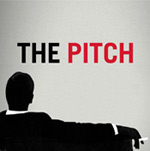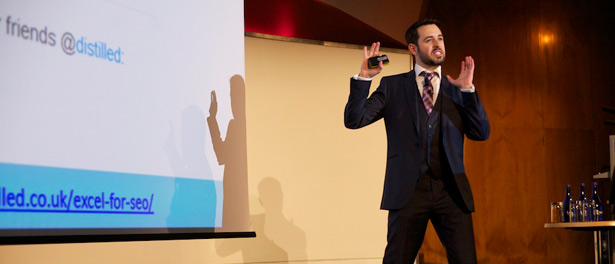
Leveraging Irrationality for Client and Stakeholder Buy-in
The author's views are entirely their own (excluding the unlikely event of hypnosis) and may not always reflect the views of Moz.
There’s an interesting dynamic in the SEO world. On the agency side, B2B sales is the drive of our business engine. In-house, we’re often pitching up the chain, to the C-suite or just below, to get budget and buy-in. Yet, for the most part, we like to model our culture after scrappy startups. That means a fun, laid back atmosphere, a “ship it” mentality, and, most importantly, flannels.

You guys get a pass since it was Lumberjack Day (allegedly).
We talk in terms of minimum viable products (MVPs), failing fast and adjusting on the fly. In The Lean Startup, Eric Ries lays out the blueprint for this approach - a way to iterate your way to success, to launch early and cheap, observe how users engage and persevere, or pivot from there.
At Distilled, my brilliant colleagues used Launchrock and an email list to measure the interest in DistilledU before investing heavily in its development. Today, DistilledU supports two full time employees and is getting better all the time. This stuff works, and an agile approach almost always trumps a big, complicated marketing plan.
We're still in the pitch game
 Distilled is a B2B service provider often working with big brands, and our average customer value is considerable. At some point, no matter how much existing trust or brand equity we have in our favor, it comes down to a small group of people making a judgment call on a sizable investment. One “no thanks” equates to tens of thousands in potential revenue, lost. If an ongoing client loses confidence in the value we're delivering, and if we fail to retain them, it has a significant negative impact on our business.
Distilled is a B2B service provider often working with big brands, and our average customer value is considerable. At some point, no matter how much existing trust or brand equity we have in our favor, it comes down to a small group of people making a judgment call on a sizable investment. One “no thanks” equates to tens of thousands in potential revenue, lost. If an ongoing client loses confidence in the value we're delivering, and if we fail to retain them, it has a significant negative impact on our business.
For in-house marketers, you might not be placed in a pressure cooker pitch situation, but you are constantly working to push your agendas up the chain and win budget from the C-suite who has no shortage of other agendas.
While we might like to think that the people across the table are weighing their options rationally (because business is a rational exercise, right?), science says otherwise.
Irrationality, spun
 If psychological studies in decision making have given us one resounding fact to sum up the human condition, it is this: we like telling, and being told, stories.
If psychological studies in decision making have given us one resounding fact to sum up the human condition, it is this: we like telling, and being told, stories.
We are so adept at crafting believable stories that we often create them on the fly and tell them to ourselves. We prefer to think we're in control of our emotions, not that they're in control of us.
Consider the Misattribution of Arousal, for example. In a 1974 study, two psychologists, Aron and Dutton, hired a woman to stand in the middle of a precarious suspension bridge and then another more secure one. She stopped men in the middle of crossing each bridge and asked them to complete a questionnaire. And upon completion, she jotted her phone number down and let the men know she’d be happy to talk later to discuss the study.
The hypothesis was that the men on the precarious bridge would be unable to separate the experience of their anxious fear from the interaction with the woman - that they would, in fact, associate their heightened senses with the context of a few minutes in her company. And it proved out. 50% of the men who crossed the suspension bridge contacted the assistant. Only 12% of the men on the safe bridge did likewise. A later experiment duplicated the results in an entirely different setting and setup.
It is this same ability to rationalize emotion-driven decisions (i.e. the ability to modify our own understanding of the context of our actions) that allows a manager to reject the ideas of a nervous SEO, or just one with an ugly haircut, and later conclude it was the content of the pitch or viability of the strategy that turned us off.
It's not just the content - superficialities matter
 In The E-Myth: Revisited, author and renowned business expert Michael Gerber points to key studies that show how far the influence of superficialities goes. Among the findings:
In The E-Myth: Revisited, author and renowned business expert Michael Gerber points to key studies that show how far the influence of superficialities goes. Among the findings:
- Salesman wearing blue suits get more business than those wearing brown suits.
- A circular logo sells better than a triangle logo, and a plaque-style logo sells best of all.
- In a sales pitch scenario, the decision to buy/hire or reject is made in the first three minutes.
In Honest Signals: How They Shape Our World, Alex Pentland explores non-language signals of human communication and details how computers programmed to tune into signals such as pitch and rhythm in a verbal conversation, as well as visual queues such as body language and mimicry, completely ignorant of content, were able to predict:
- From audio of pitches by entrepreneurs, which business plans would be judged by business school students as successful.
- From audio of sales calls, which calls would be successful (with 80% accuracy).
- From monitoring the female’s signals in speed dating conversations, the interactions in which couples exchanged their phone numbers.
We tell ourselves that these petty superficialities don't fool us, and that we won't judge the quality of content by the way its dressed up or the tone of voice in which it is delivered, but the science simply proves we're wrong. Appearance and delivery matters a great deal more than we'd like to think.
If you can count on one thing walking into a pitch environment, count on being evaluated on visual and superficial signals as much as the content of your presentation. The content, in fact, will never permeate the decision making process of potential clients and stakeholders if you don't build trust with the right verbal and visual queues.
A few guidelines to help leverage this in your favor:
1. Practice up
Rehearsing your pitch/presentation is a good way to get comfortable with the material.
In an open and humble recent blog post, Ross Hudgens explains how he got better at public speaking by rehearsing his presentations 4-5 times and recording himself on video. In his first speaking engagements, he felt nervous and embarrassed by his performance, and monitoring feedback made it clear the audience hadn't responded as well as he'd have liked. Now Ross is invited to speak at some of the biggest conferences in the game, and having seen him do so in person, I can vouch for the quality and confidence he brings to the stage.
It also helps if you actually believe in what you're saying. No joke here; as controlled and practiced as you may be, at some point a lack of confidence and passion in your topic shine through. People are remarkably fine-tuned BS-detectors.
2. Dress the part
No need for much elaboration on this one. Unless you're pitching to a start-up (and even then), chances are business casual or better is going to be in your favor.
Dust off your dress shoes. Hey, it can be fun to look sharp once in a while.
Right, Rand?

Maybe the world would be a better place if petty matters like the quality of one's attire didn't enter into our judgment, but we've evolved to incorporate visual queues into our thinking. Pragmatically, if dressing sharply tips the scales in our favor, why not use it?
3. Invest in design
Mike King's presentations have taken on legendary status.
At MozCon he rapped on stage with the backdrop of a slick kinetic typography video. Professionally designed.
At SearchLove Boston this November, his slide deck on getting iAcquire back into the index was beautiful. Every slide was designed with care. Again, Mike had a graphic designer working with him. During his talk, Mike mentioned that "it all matters" when it comes to visuals. Every little detail.
Rand has also stepped up his slide deck design by taking a similar approach - he's outsourcing to a Seattle design firm. His "head to head" presentation at SearchLove was gorgeous.
If it's worth walking into a room to pitch an idea, it's worth the preparation and investment to ensure your argument is well-packaged.
4. Focus on the "why"
The messages that resonate with us go deeper than the facts.
Apple's anti-establishment message. Cisco's "The Human Network." SEOmoz's TAGFEE values.
Business is never "just business." If you want to motivate, you need to get at the human values behind what you're pitching.
Ian Lurie's presentation at SearchLove this year, and a following webinar here at SEOmoz, are excellent starting points for framing your ideas around the "why," not just the "what" and "how."
This talk from Simon Sinek is also a phenomenal primer in how this principle helps businesses inspire their audiences:
A reading list on irrationality and how it influences our choices
If you're interested to learn more about the irrational ways we make decisions and rationalize them later (a topic I personally find limitlessly fascinating), these books are rich with deep insights:
.jpg) Predictably Irrational by Dan Ariely
Predictably Irrational by Dan Ariely
A psychologist and professor at Duke University, Dan has written several books explaining our irrational behaviors and tendency to rationalize them. This is perhaps his best to date and the book that made him famous. Rand wrote up a nice summary of the book and 10 irrational behaviors that can be utilized for web marketing here.
 Honest Signals: How They Shape Our World by Alex Pentland
Honest Signals: How They Shape Our World by Alex Pentland
As briefly described above, this book is about the complex network of non-language human communication that Pentland argues is at the core of our interactions. And the data backs him up. We pick up on these signals without even being aware of them, and they have a lot more to do with the outcomes of our interactions than we may think.
 Influence: The Psychology of Persuasion by Robert Cialdini
Influence: The Psychology of Persuasion by Robert Cialdini
No list about the power of irrationality in our decision making is complete without this classic from Robert Cialdini. This book covers six secret weapons of influence and how they influence our decisions - all backed up with psychological studies. Dean Rieck over at Copyblogger wrote a nice post that summarizes all six methods.
 You Are Not So Smart by David McRaney
You Are Not So Smart by David McRaney
This book is mainly comprised of posts from David's blog of the same name expanded-upon and revised for publication. I can't recommend this blog, or book, highly enough. The posts/chapters are in-depth (often as long as 4,000 words) and go into great detail around the studies that prove how our irrational behaviors work and how it is we're unaware of the machinery behind the scenes. David now hosts a podcast that's equally compelling.
There is no shortage of articles and resources out there that dive into this topic. I'm sure you have your own favorites. Share some in the comments!



Comments
Please keep your comments TAGFEE by following the community etiquette
Comments are closed. Got a burning question? Head to our Q&A section to start a new conversation.